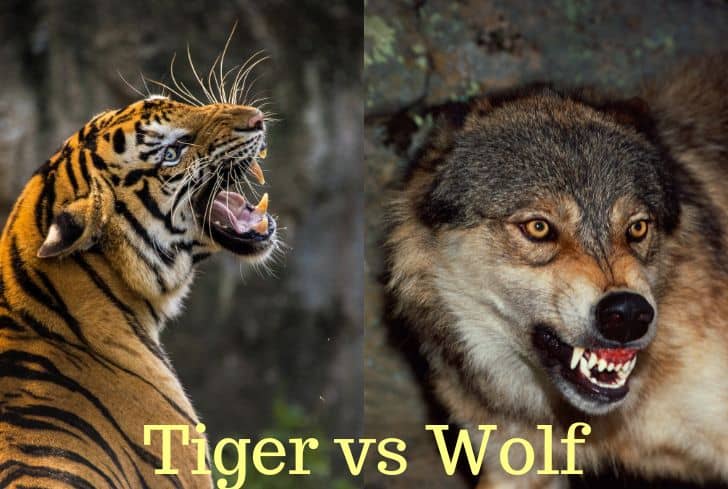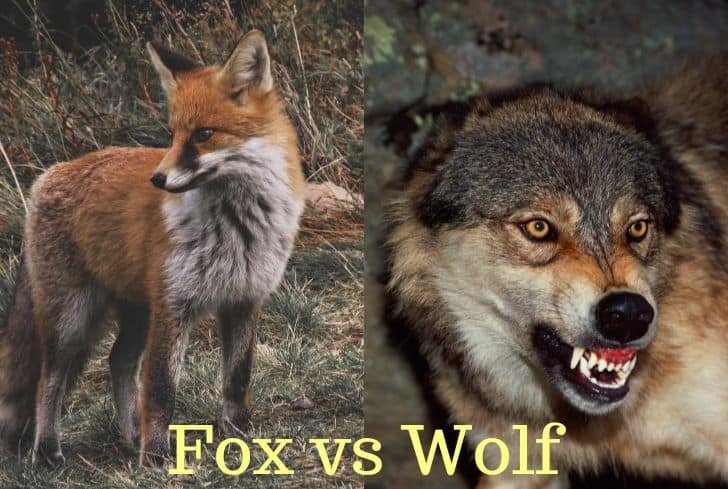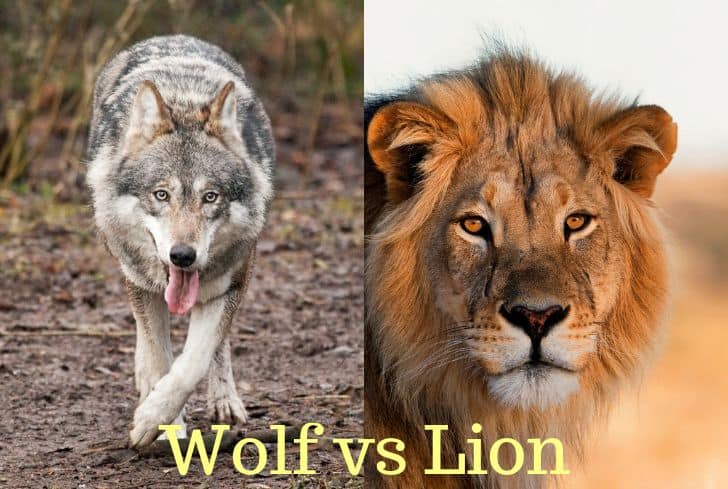Coyote vs Wolf [Differences & Strength Comparison]

Coyote and Wolves are both capable and fearsome predators in their own right. They each have their own traits that are unique to them. One question that might arise when you think of these two animals is which one could win in a fight.
In this article, we will compare the specifics of what makes a coyote a coyote and a wolf a wolf before finally figuring out which one will win in a fight.
What is a Coyote?
The coyote (Canis latrans) is a species of canine native to North America. The coyote stands about 60 cm (24 inches) at the shoulder, weighs about 9–23 kg (20–50 pounds), and is about 1–1.3 metres (3.3–4.3 feet) long, including its 30–40-cm tail. These members of the dog family once lived primarily in open prairies and deserts, but now roam the country’s forests and mountains. The coyote, whose name is derived from the Aztec coyotl, is found from Alaska southward into Central America but especially on the Great Plains.
What is a Wolf?
The wolf also known as the gray wolf or grey wolf, is a large canine native to Eurasia and North America. They have pointed ears, elongated snouts, and bushy tails that curl behind them as a means of expression. The average wolf typically weighs somewhere between 80 and 160 pounds. Wolves can live up to 13 years in the wild, but most die long before that age.
| Characteristic | Coyote | Wolf |
| Family | Canines | Canines |
| Length | 3.3 to 4.3 feet long | 2 meters or 6.6 feet long |
| Weight | 9 to 23 kilograms or 20 to 50 pounds | 14 to 65 kilograms or 31 to 143 pounds |
| Height | 60 centimeters or 24 inches | 76 centimeters or 30 inches |
| Habitat/Location | North America/Deserts, Prairies, Urban areas with people | North America, Eurasia/ Tundra, woodlands, forest, grasslands, and desert habitats |
| Food/Diet | Omnivores | Carnivores |
| Bite Power | 88 PSI | 400 PSI |
| Speed | 35 to 43 mph | 31 to 37 mph |
| Color | Combination of gray, brown, red, white | Combination of white, brown, gray, and black |
| Sound | Growling, Laughing, Screaming, Whining, Barking, Yipping | Howling, whimpering, growling, and barking |
| Paws | Large oval paw with four toes. Less space between the toes. Also has a prominent heel | Large, oval paws with four toes. Long middle toe |
| Senses | Keen sense of smell, hearing, and sight | Strong sense of smell, can see in the dark and process rapid movement and can hear high-pitched sounds |
Coyote vs Wolf
In this section, we will take a deeper look at the chart and delve into the differences between a wolf and a coyote.
Coyote vs Wolf: Family
The wolf or grey wolf as it is also commonly known as (Canis lupus) and coyote (Canis latrans) both belong to the canine family. While both are native to North America, wolves can also be found in Eurasia. The farthest the coyote was found was in eastern Panama back in 2013, but this is not common.
When it comes to subspecies, it depends on the animal. There are more than thirty subspecies for wolves. Coyotes have about 19 subspecies, which is significantly less if you compare it to wolves.
Unfortunately for all wild wolves, the global population was only about 300,000 all the way back in 2013. However, the population is growing in recent years, and they are not considered endangered. For coyotes their population is also growing significantly, and they are also not considered endangered.
Coyote vs Wolf: Size
Coyotes, like we said, are smaller than wolves. They are usually about 1 to 1.3 meters or 3.3 to 4.3 feet long. This includes the tail just like it does with wolves. If you compare the two, you will find that wolves do have a significant size advantage over coyotes.
Wolves happen to be the largest living member of the canine family and while the coyote is a decent size in its own right, they are smaller than wolves. A male wolf is usually around 2 meters or 6.6 feet long. This also includes the tail. Females are about 20 percent smaller than males usually, so they would probably not get to 6+ feet long.
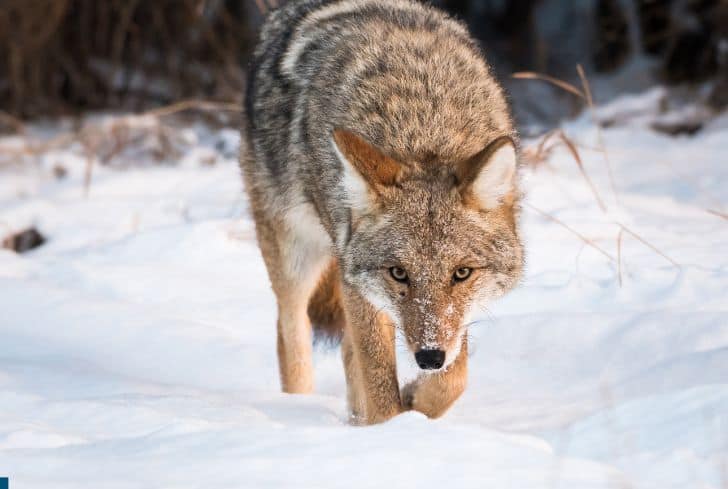
Coyote vs Wolf: Weight
Weight refers to how heavy an object or creature is. Coyotes are smaller than wolves, which is just a fact so it should be no surprise that they weigh less than wolves. The weight range for coyotes is about 9 to 23 kilograms or 20 to 50 pounds.
For wolves, their weight can range from 14 to 65 kilograms or 31 to 143 pounds. The reason for this large variety is due to the many different subspecies of wolves that can be found in North America and Eurasia. However, even at the smallest range, which is 31 pounds, wolves are still larger than the coyotes on the smallest end of the spectrum.
Coyote vs Wolf: Height
When you are trying to figure out the height of an animal, it is basically you trying to find out how tall it is while it stands on all of its legs. For coyotes, they reach up to 60 centimeters or 24 inches tall, which is also measured around the shoulder.
The wolf stands roughly about 76 centimeters or 30 inches tall at around the shoulder. The heights between the two are similar. Wolves are only about 6 inches taller than a coyote, but when you are in the middle of the fight, this slight advantage could be what helps the animal in question win. However, we are not going to look at this right now and will address it later in the article.
Coyote vs Wolf: Habitat
Coyotes can be found almost all-over North America. It does not matter if it is a city, suburb, farm, or rural area. You can find them there. They prefer open areas like prairies and the desert, they can adjust and survive seemingly almost anywhere.
While wolves can also be found in Eurasia, they are mostly found across North America. They can be found in places like Alaska, Michigan, Wisconsin, Montana, Wyoming, Oregon, Idaho, and even Arizona or New Mexico. Habitat wise, they can live in many different kinds of habitats. This includes tundra, woodlands, forest, grasslands, and deserts.
It really is impressive that coyotes are so adaptable. This is truly a skill a wolf should envy!
Coyote vs Wolf: Food
Since coyotes eat both meat and plants, their diet is more varied. They eat rabbits, dead animals, chickens, deer, rats/mice, watermelons, and berries. Wolves, on the other hand, don’t have very much of a varied diet. They especially like to eat large, hoofed animals like moose, bison, deer, and elk. However, they will eat smaller mammals if necessary. This includes such animals like beavers, mice, rats, and hares.
Wolves are carnivores. This means that they are primarily meat eaters and will hunt their prey for food. Coyotes, on the other hand, are omnivores, which means they eat both meat and plants. So, in some ways their diet is similar.
Coyotes are impressive in their own right, but the fact that wolves hunt such large animals is pretty darn awesome.
Coyote vs Wolf: Bite Power
Coyotes have a much smaller bite power, though please don’t count them out of this fight yet. A coyote’s bite power or PSI is at 88. They tend to eat smaller animals and plants so this explains why their bite power might be on the less powerful side when compared to wolves.
Wolves are the larger of the two animals so it should be no surprise that their bite power or pressure per square inch is about 406. In the canine species, this is considered to be the most powerful PSI out of all of them. Remember that they tend to hunt very large animals as their prey such as moose. An animal is going to need a very strong bite power to take down an animal as strong as that!
Coyote vs Wolf: Speed
The speed of an animal can make all the difference during a hunt or a fight. A coyote’s speed can get all the way to 43 mph or 69 km/h. A typical range falls between 35 to 43, with 43 being the fastest they can go. Interestingly enough, the wolf has a similar range but can’t reach up to speeds as high as 43 like the coyote.
A wolf’s range of speed falls between 31 to 37. This is the fastest they can reach, which is pretty awesome to be honest. It just means that they are a little slower compared to coyotes. This does give the coyotes a slight boost, which they need since the wolves have advantage in several other areas.
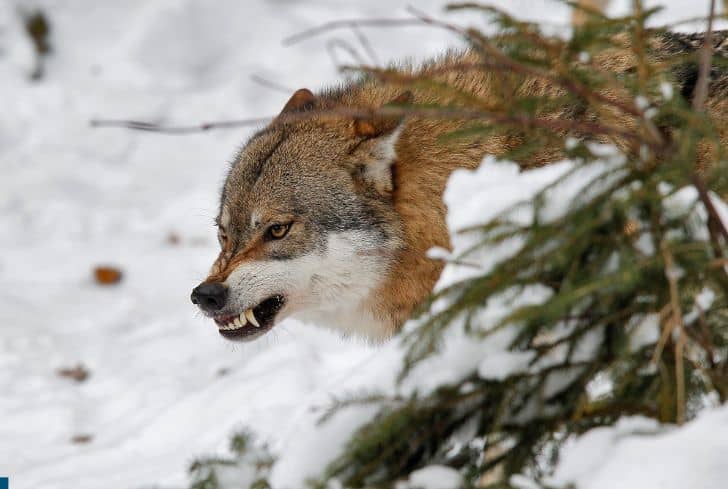
Coyote vs Wolf: Color
When it comes to coyotes, colors can differ depending on where they happen to live or if there are any mutations involved. They usually tend to be many colors at once. This includes gray, brown, red, white, etc. It is a combination of colors that makes it very unique when you think about it.
The most common color of a wolf is a mixture of white, brown, gray, and black. Interestingly enough, there are subspecies in the arctic region that could be completely white. A wolf’s color combination is similar to that of a coyote with the exception of there being no red in their fur.
Coyotes and wolves basically have what can be described as a mottled coat.
Coyote vs Wolf: Sound
Coyotes make similar noises to wolves, but there is a little more variety when you look at these animals. They can make noises like whining, barking, laughing, screaming, yipping, and growling.
When you think of a wolf, you think of them howling. This is popularized in the media and does have truth to it. Wolves do indeed howl. However, this is not the only sound they are able to make. They also communicate with whimpering, barking, and growling. There could even be a mixture of sounds like a bark-howl or growl-bark. In some ways it’s similar to what you would see with other canines.
Coyote vs Wolf: Paws
Both coyotes and wolves have paws, but there are some differences when you take a close look at them. Coyotes have four toes on each pad like a cat or dog basically. However, they have more of a prominent heel and less space between the toes.
For wolves, they also have four toes and an oval-shaped paw. The main difference is that the middle toe of a wolf is usually longer with some webbing that can be found between the toes.
Coyote vs Wolf: Senses
Coyotes are similar to wolves in the sense that their senses are heightened. They have a keen sense of hearing, sight, and smell.
Wolves’ senses are heightened but this should come as no surprise. They have good vision and can see in the dark as well as process rapid movement. Sound wise, they are able to hear higher pitched sounds than we can. Their most powerful sense has to be their sense of smell. It’s 100 times more powerful than ours!
Who Would Win in a Fight? Coyote or Wolf
We’ve compared wolves and coyotes based on several different types of criteria. Now the main question is who would be the one to win in a fight?
If there was a fight between a coyote and a wolf, the wolf would be the clear winner. The honor belongs to the wolf which should really come as no surprise. A wolf is much larger than a coyote in height, weight, and size. Plus, look at their bite force. The coyote can’t come close to having a PSI as powerful as a wolf.
Final Thoughts
And there you have it my dear readers. We have gone through and compared wolves and coyotes based on their appearance, behaviors, habitat, etc. This was necessary so we could finally deduce who the winner would be if the two of these animals were to go head-to-head in a fight.
The coyote is a fearsome predator in its own right, but it simply can’t stand up against the wolf and its bite.

![Hyena vs Wolf [Differences & Strength Comparison]](https://eartheclipse.com/wp-content/uploads/2022/08/Hyena-vs-Wolf.jpg)
![Hyena vs Coyote [Differences & Strength Comparison]](https://eartheclipse.com/wp-content/uploads/2022/08/Hyena-vs-coyote.jpg)
